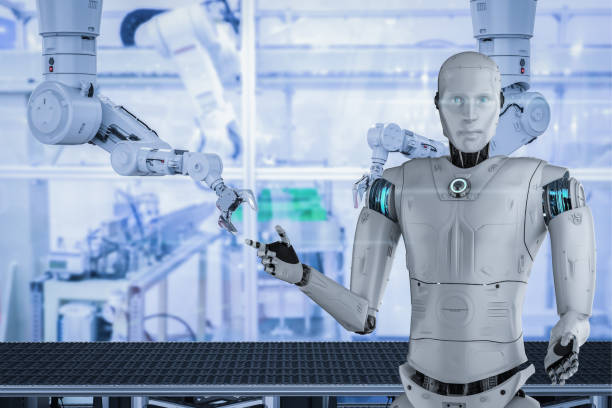Robotics Renaissance: From Factories to Daily Life
In the contemporary landscape, the term “robotics” no longer conjures images solely of futuristic sci-fi scenarios. Instead, we find ourselves amidst a Robotics Renaissance—a period marked by the proliferation of robotic technologies, their integration into diverse industries, and their gradual entrance into our daily lives. From manufacturing floors to healthcare, homes, and beyond, robots are evolving from specialized tools to versatile collaborators, ushering in a new era where human-machine collaboration is transforming the way we work, live, and interact with technology.
Evolution of Robotics
The roots of modern robotics can be traced back to the mid-20th century, with early applications in industrial automation. These early robots were largely confined to controlled environments, performing repetitive and dangerous tasks in manufacturing settings. Over the decades, advancements in sensors, artificial intelligence (AI), and materials have fueled a paradigm shift, enabling robots to break free from the confines of factory floors and venture into new realms.
- Industrial Robotics:
Automating Manufacturing Processes: The initial wave of industrial robotics focused on automating repetitive and strenuous tasks in manufacturing. Robots became integral to processes like assembly, welding, and material handling, enhancing efficiency and precision.Collaborative Robots (Cobots): A significant development in industrial robotics is the emergence of collaborative robots. Cobots are designed to work alongside humans, facilitating a symbiotic relationship where each contributes their unique strengths. This shift towards human-robot collaboration marks a departure from traditional, isolated robot workspaces.
- Service Robotics:
Healthcare Assistants: In healthcare, robots are increasingly being employed to assist medical professionals. Surgical robots, for example, enhance the precision of surgical procedures, while robotic exoskeletons aid in rehabilitation and mobility support.Autonomous Vehicles: The automotive industry has embraced robotics in the form of autonomous vehicles. Self-driving cars, drones, and other autonomous systems leverage robotics and AI to navigate and make decisions in dynamic environments.
Robotic Applications Beyond Factories
- Healthcare:
Surgical Robotics: Robots like the da Vinci Surgical System assist surgeons in performing minimally invasive surgeries with enhanced precision. These systems use robotic arms controlled by surgeons, offering greater dexterity and accuracy.Rehabilitation Robotics: Exoskeletons and robotic prosthetics are transforming rehabilitation for individuals with mobility impairments. These robotic devices assist patients in regaining movement and independence.
- Agriculture:
- Autonomous Harvesting: Agricultural robots equipped with computer vision and robotic arms are employed for tasks like fruit picking. These robots can work autonomously, reducing the labor-intensive nature of certain agricultural processes.
- Precision Farming: Robots equipped with sensors and AI are utilized for precision farming. They can analyze data on soil conditions, monitor crop health, and optimize the use of resources such as water and fertilizers.
- Retail and Logistics:
- Warehouse Automation: Robots are transforming logistics and e-commerce through automated warehouses. Autonomous robots navigate storage facilities, retrieve items, and prepare orders, streamlining the order fulfillment process.
- Customer Service Robots: In retail settings, robots are being deployed for tasks such as inventory management, cleaning, and even customer assistance. Some robots can engage with customers, providing information and guidance.
- Education:
- Educational Robotics: Robots are entering educational settings to facilitate interactive and experiential learning. Educational robots engage students in programming, problem-solving, and STEM (Science, Technology, Engineering, and Mathematics) activities.
- Robotic Assistance in Special Education: In special education, robots are used to provide personalized assistance and support to students with learning challenges. These robots can adapt to individual learning styles and pace.
The Impact on Daily Life
The Robotics Renaissance is not confined to specialized industries; it is permeating our daily lives in ways that were once the stuff of science fiction.
- Smart Homes:
- Domestic Robots: Robots designed for home use are becoming more commonplace. Vacuum-cleaning robots, such as Roomba, autonomously clean floors, while companion robots like Jibo offer social interaction and assistance with various tasks.
- Home Security Robots: Robots equipped with cameras and sensors contribute to home security. These robots can patrol the premises, detect unusual activities, and provide real-time video monitoring.
- Personal Assistance:
- Personal Assistants: Virtual personal assistants, powered by AI and natural language processing, are a form of robotic technology integrated into our smartphones and smart devices. Examples include Siri, Alexa, and Google Assistant, which provide information, perform tasks, and facilitate voice-controlled interactions.
- Robotic Proxies: Telepresence robots enable individuals to be present in a remote location through a robot equipped with a camera and screen. These robots serve as proxies for virtual communication in professional and personal contexts.
- Entertainment:
- Robotic Toys: Robotics has entered the realm of entertainment through robotic toys that engage and entertain children. These toys may have interactive features, movement capabilities, and even basic AI for responsive play.
- Theme Park Robots: Theme parks are incorporating robotic characters and attractions. These robots can interact with visitors, enhancing the overall experience and blurring the lines between fantasy and reality.
Challenges and Considerations
- Ethical Considerations:
- Job Displacement: The increased integration of robotics raises concerns about job displacement. As robots take on routine tasks, there is a need for reskilling and upskilling the workforce to adapt to a changing employment landscape.
- Bias in AI: AI, a key component of many robots, may perpetuate biases if not properly designed and trained. Ensuring fairness and transparency in AI algorithms is crucial to avoid reinforcing societal inequalities.
- Safety and Regulation:
- Human-Robot Interaction: Ensuring the safety of human-robot interactions is paramount. Standards and regulations must be established to address safety concerns, particularly as robots operate in shared spaces with humans.
- Data Privacy: The use of robotics often involves the collection and processing of personal data. Safeguarding data privacy and ensuring secure communication channels are critical considerations.
- Cost and Accessibility:
- Affordability: The cost of advanced robotic technologies can be a barrier to widespread adoption, especially for smaller businesses or individuals. Efforts to reduce costs and enhance affordability are essential for broader accessibility.
- Technological Accessibility: Ensuring that advancements in robotics are accessible to individuals with diverse abilities is vital. Efforts should be made to design inclusive technologies that accommodate different needs and preferences.
Future Trends and Innovations
- Human-Robot Collaboration:
- Enhanced Collaboration in the Workplace: Future workplaces may see increased collaboration between humans and robots, where each contributes its unique strengths. Robots may handle repetitive tasks, freeing humans to focus on creative and complex activities.
- Medical Robotics Advancements: In healthcare, robotic systems are expected to evolve for more intricate surgeries, diagnostics, and patient care. The development of miniature robots for targeted medical interventions is a potential avenue.
- Autonomous Systems:
- Autonomous Vehicles Integration: The integration of autonomous systems, including drones and self-driving vehicles, is poised to become more widespread. These systems may play a significant role in logistics, transportation, and even emergency response.
- Robotic Delivery Services: The use of robotic delivery services, including ground-based robots and drones, is likely to expand. This could revolutionize last-mile delivery and enhance the efficiency of e-commerce logistics.
- Humanoid Robotics:
- Advanced Humanoid Robots: Developments in humanoid robotics may lead to more advanced and versatile human-like robots. These robots could find applications in various fields, including healthcare, customer service, and even personal assistance.
- Emotional Intelligence in Robots: Future humanoid robots may be equipped with enhanced emotional intelligence, allowing them to understand and respond to human emotions. This could make interactions with robots more natural and empathetic.
Conclusion
The Robotics Renaissance is propelling us into an era where robots are no longer confined to factory assembly lines but are active participants in diverse facets of our lives. From healthcare and agriculture to our homes and daily routines, the integration of robotics is reshaping industries and enriching our human experience. As we navigate the ethical considerations, safety protocols, and accessibility challenges, the trajectory of robotics is poised to further evolve. The future promises not only increased efficiency and productivity but also new possibilities for collaboration, innovation, and a redefined relationship between humans and machines. The Robotics Renaissance is not just about the evolution of technology; it signifies a profound transformation in the way we perceive, interact with, and benefit from the capabilities of robots in our ever-changing world.







[…] Line and Pipeline Inspection: Drones are employed for inspecting power lines, pipelines, and other critical infrastructure. They can navigate […]